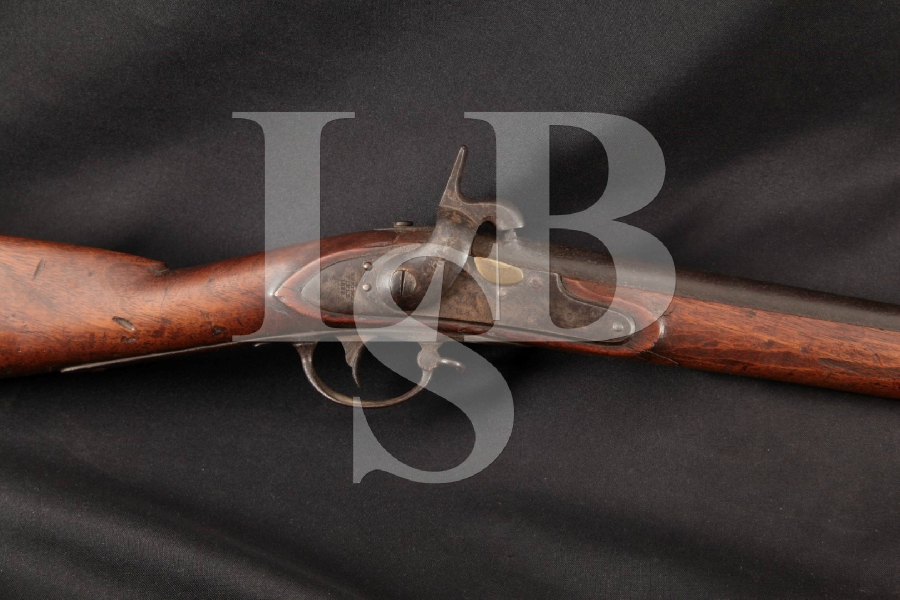
Springfield 1835 / 1840 Conversion Model, U.S. Marked & Named Stock, Brown 42” Single Shot Percussion Rifle, MFD 1838 Antique
Sold For: $2,138.00
LSB#: 160825MD21
Make: Springfield Armory
Model: 1835 Converted to M1840
Serial Number: The top of the barrel by the upper tang appears to be marked either 38 or 88.
Year of Manufacture: 1838
Caliber: .69 Caliber Ball
Action Type: Single Shot, Muzzle Loaded Percussion Rifle
Markings: The top of the barrel appears to be marked “38” or “88”. The left side of the stock has two oval cartouche marks, another is found on the belly, the letters are very faint; the initials “JA” are on the belly as well. The left side plate is marked “S”. The initials “IMS” are carved on the underside of the stock, the left of the butt is hand carved “J.M. Thaddock”, the right is hand carved “H.K.M.” The lock plate is marked “SPRING / FIELD / 1838 / U.S.”
Barrel Length: 42”, with three iron barrel bands.
Sights / Optics: The front sight is a rounded half-moon blade, that is integral to the forward barrel band, there is no rear sight.
Stock Configuration & Condition: The stock is American walnut, with brass fixtures. The stock has two sets of initials and name of “J.M. Thaddock” carved into the surfaces, there are three oval cartouche stamps and the initials “JA” stamped on the belly. The forward sling swivel is mounted on the middle barrel band, the rear is mounted on the trigger guard. The stock has heavy gouge marks that look to have been made long ago; there are un-repaired cracks around the lock plate, the stock has chip losses around the chamber, upper forend and tang areas. The stock looks to have been whittled on as there are planes of wood missing on the flanks of the forend between the lock plate and rear band; this may have been done for traction. The LOP measures 13 3/8” from the front of the trigger to the back of the metal butt plate. The stock rates in about Good overall condition.
Type of Finish: The barrel is browned, the bands are unfinished iron, the lock plate was case colored.
Finish Originality: All Original
Bore Condition: The smooth bore is dark and there is moderate erosion the length of the bore.
Overall Condition: This rifle retains about 0% of its metal finish. The metal surfaces have scabs of surface erosion and faint scrape marks. The side plate has natural tarnish and spots of pin prick erosion. The brass flash tray filler has a gold/brown patina and dings. The barrel has areas of mild to moderate pitting as photographed. The screw heads are mildly tooled. The markings are faded but legible. Overall, this rifle rates in about Good condition for its age.
Mechanics: The action functions correctly. We have not fired this rifle. As with all previously owned firearms, a thorough cleaning may be necessary to meet your maintenance standards.
Box, Paperwork & Accessories: Included is a metal ram rod, with patina, light pitting and handling marks, in about Good condition.
Our Assessment: From https://en.wikipedia.org/wiki/Springfield_Model_1835 “The Model 1835 was produced by the Springfield Armory, and was also produced by the Harper’s Ferry Armory and other contractors. It was a smooth bore musket and fired a .69 caliber round ball.[1] The Model 1835 is sometimes considered to be its own model number, but is often considered to be just a continuation of the Model 1816 Musket.The barrel was slightly longer than the Model 1816 and the total weight of the Model 1835 was slightly higher, but otherwise the Model 1835 was very similar to the Model 1816. Even though the final product was very similar, significantly different manufacturing techniques were used in the creation of the Model 1835, and a great deal of emphasis was placed on parts interchangeability. This paved the way for the Springfield Model 1842 which was the first musket to be constructed of all interchangeable parts.[2] Most 1835 muskets had the flintlock replaced with a percussion lock during the 1840s and 1850s. Some of the 1835 muskets also had their barrels rifled during this same period, if the barrel was deemed to be thick enough to be structurally sound after rifling. The model 1835 was used by both the North and South during the American Civil War. The model 1835 was also used in the Mexican-American War.[3]” This rifle was made in 1838 and was converted from flintlock to percussion soon after. The stock has two sets of initials and the name J.M. Thaddock are found on the stock, giving this rifle a bit of personal history. The metal has not been refinished and has honest patina. We can only imaging what this rifle’s resume looks like and we wish it could tell us. If you’re a collector of Mexican / American or Civil War weaponry, your collection would be proud to have this one. Please see our pictures and good luck.

